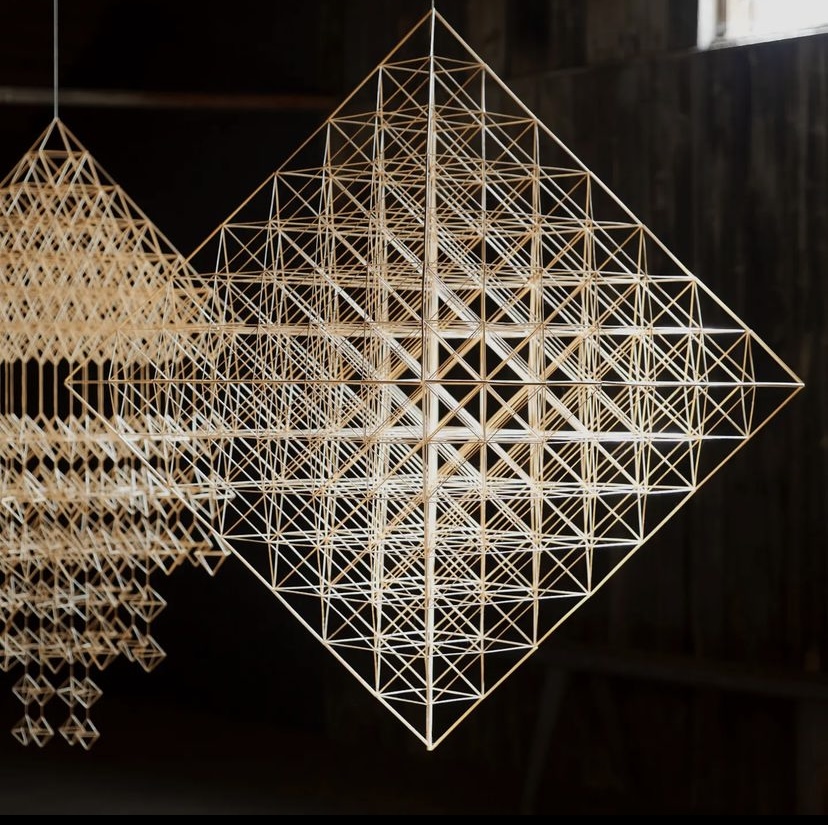Paimion parantolan joulun ajan näyttely on kunnianosoitus perinteille ja käsityölle.
Himmelin parantava voima -näyttely tuo parantolan tiloihin kansainvälisesti tunnetun himmelisti Eija Kosken käsityön arkkitehtuuria.
Näyttelyn rinnalla on parantolan huoneisiin ripustettu vanhoja, alkuperäisiä himmeleitä, jotka parantolan entinen osastonhoitaja Tuula Paakkanen on entisöinyt.
Eija Kosken himmelinäyttelyt ovat olleet laajasti esillä kansainvälisissä museoissa ja gallerioissa. Parantolan näyttely on ainutkertainen kokemus kokea himmelien energiaa ja kauneutta myös Suomessa.
Himmelin parantava voima
23.11.–15.12.2024
Avoinna: Keskiviikko–sunnuntai klo 10–18.
Vapaa pääsy.
Tervetuloa avajaisviikonloppuun 23.–24.11.2024.
***
Nälänhätä. Jouluruoka. Geometria. Jumalallinen järjestys. Platoniset kehät. Harmonia, symmetria. Kaikki tämä tiivistyy vanhaan suomalaiseen jouluperinteeseen, himmeliin.
Himmelit ovat ”rakennettuja”, eivät ”askarreltuja”, sillä niillä ei ole mitään tekemistä perinteisten joulutähtien askartelun kanssa.
Himmelit ovat monimutkaisia kolmiulotteisia geometrisia rakenteita, joiden rakentamiseen tarvitaan aikaa ja rauhaa. Työn valmistelu vaatii häiriintymättömyyttä ja meditatiivista omistautumista projektille.
Sana himmeli on peräisin germaanisista kielistä, tarkemmin sanottuna ruotsista, ja tarkoittaa kirjaimellisesti ”taivasta.” Toinen nimitys tälle on ”olkikruunu.” Muodon on oletettu saaneen inspiraationsa keskiaikaisista kirkoista löytyvistä kynttiläjaloista. Himmeli oli joulukoristeena kaikissa suomalaisissa kodeissa, ei vain maalaistaloissa, vaan myös kaupungeissa aina noin vuoteen 1870 asti.
Himmelit on rakennettu jouluksi ja ripustettu olohuoneeseen onnen tuojaksi hyvälle sadolle. Mitä suurempi onnen tuoja, sitä suurempi saattoi olla toivo vielä suuremmasta sadosta. Tämä tarkoittaa, että oli olemassa todella suuria himmeleitä, jotka voitiin rakentaa vain ripustamalla ne talliin ja kokoamalla ne samankaltaisiksi.
Miksi ruista, eikä vehnää tai kauraa? Talvenkestävä ruis, eli talviruis, on kaikkein kestävin viljalaji ja se on vuosisatojen ajan ollut elinehto väestön selviytymiselle Suomessa. Ruista kutsutaan myös jumalten viljaksi tai Jumalan viljaksi, ja se on ollut tärkein peruselintarvike Suomessa.
Himmeli symboloi myös luonnon ja ihmisen välistä yhteyttä: kasvaessaan ruis taipuu varresta muodostaen pieniä niveliä, mikä on nähty ihmisen elämän symbolina. Elämä etenee vaiheesta toiseen. Joulun jälkeen himmelit poltettiin, jotta seuraavana vuonna voitaisiin aloittaa taas alusta. Tämä oli myös käytännön syistä, sillä on hankalaa säilyttää niin herkkää rakennetta.
Joulu oli maatalousyhteisölle vuosisatojen ajan ainoa päivä vuodessa, jolloin sai levätä ja nauttia ruuasta. Jouluruoka ei peitetty, vaan jäi pöydälle. Tämä perinne elää yhä monissa suomalaisissa perheissä, vaikka nälänhätää ei olekaan nykyään samalla mittakaavalla.
Himmeli on muistutus tästä ajasta, omasta alkuperästä, historiasta sekä luonnon ja ihmisen välisestä yhteydestä. Se on myös abstraktimpi symboli universaalista kauneudesta ja harmoniasta.
Platon on kuvannut universaalia kauneutta geometristen muotojen perusteella. Niin sanotut viisi platonista kappaletta—tetraedri, oktaedri, kuutio, ikosaedri ja dodekaedri—ovat polyedrejä, eli monikulmioita, joilla on suurin mahdollinen symmetria.
Platonin mukaan nämä muodot muodostavat universumin harmonian perustan. Perinteisessä himmelissä oktaedri on keskeinen muoto. Oktaedriä kutsutaan myös taivaaksi ja maaksi, ja sen elementti on ilma. Himmeli ilmentää ilmaa—tilaa ja tyhjyyttä—joka syntyy geometrisessa muodossa olkien, eli reunojen, väliin.
Himmelin harmonia syntyy siten muodosta (oktaederista), suhteista (oktaedereiden koosta toisiinsa nähden, usein kultaisen leikkauksen mukaan) sekä symmetriasta.
Taivas on aina symmetrinen; se roikkuu korkeimmalla kohdallaan, ja on näin ollen peilisymmetrinen.

